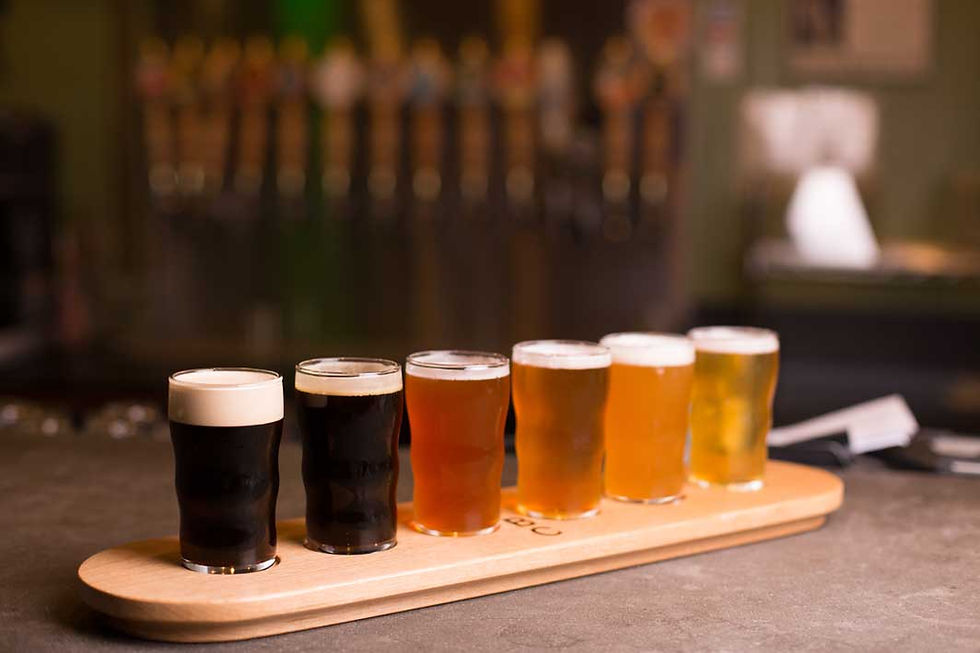Want Variety in Your Life? Look to Beer
- David Nuttall

- Jun 7, 2021
- 4 min read

Although beer has been around for countless millennia, its separation into styles and categories is somewhat recent. While scholarly analysis used to be primarily for beer judging and homebrewing, the average consumer now needs a modicum of brewing knowledge simply to wade through all the brands and styles currently available.
Just 30 years ago, there was only a handful of national breweries in North America, all producing basically the same kind of beer, along with a sprinkling of craft breweries offering a couple of styles each. Restaurants and bars tended to be aligned with a single supplier, and liquor stores carried a few local craft beers and imports to break up the monotony of mass-produced lagers. Basically, when you found your favourites, you stuck with them for life. That methodology no longer applies.
It’s impossible to know how many different varieties of beer have ever been made, given that brewing was largely a cottage industry up to about 200 years ago. Until craft brewing arrived in the last quarter of the 20th century, beers were usually classified by the brewery or region of origin. Governments got involved for taxation and regulatory reasons, but for the most part, no one really cared about beer’s nomenclature.
By the time brewing had expanded through the Industrial Revolution, it became even less important. Breweries actually started producing less varieties of beer as they grew larger, given the enormous cost of development, production, and marketing needed for each new line. In the last century, breweries were more likely to change the packaging of an existing brand than introduce a new product.
Today there is more potential for creativity than ever before. Beers now get defined by their history, region, ingredients, production method, colour, alcohol content, or bitterness.
This began to change when a perfect storm arrived in 1976; Jimmy Carter got elected president of the United States and Michael James Jackson started writing The World Guide to Beer. These unrelated events kickstarted the craft brewing industry and initiated the avalanche of beer varietals that define 21st century brewing. Jackson’s book got published in 1977, and a year later, Carter legalized homebrewing again (banned since Prohibition began in 1920). This inspired thousands of university students and young professionals to study and brew beers similar to those mentioned in Jackson’s book, exploring styles unavailable in local stores and bars. Over the next decade, many of these neophytes opened small breweries all over North America.
These new breweries usually started with two-to-four different beers; mostly ales since lagers take longer and are more finicky to brew. Knowing they had to compete against giant brewing conglomerates, they explored varieties not common in their market. The twentyfold (in Canada) to thirtyfold (United States) increase in the number of breweries over the next three decades led to a corresponding proliferation of beer categories in both the Brewers Association and Beer Judge Certification Program style guidelines.
Certainly not all the categories are new; many are just reviving long-forgotten styles that brewers simply quit brewing years, or centuries, ago. However, today there is more potential for creativity than ever before. Beers now get defined by their history, region, ingredients, production method, colour, alcohol content, or bitterness.

Thanks to dynamic breeding programs, largely in the American northwest, over the past 50 years, the growth of hop varieties has had the biggest influence on brewing recipes. The study of terroir’s influence, genetic diversity, agronomic characteristics, yield generation, and commercial viability, all play a part. Hop farmers now regularly work with brewers, searching for new or distinct flavour profiles. For example, the long-established English India Pale Ale (IPA) has mutated into over a dozen variants in this century alone thanks mainly to hop derivations.
While hops continue to drive new beer styles, both malt and yeast advancements are not far behind. Specialty malt houses and yeast labs are continually working with and offering new options to breweries that improve brewing efficiency and shape different beer characteristics. Unusual ingredients like pastries, pizza, peanut butter, oysters… literally anything edible, pushes the boundaries even further. Access to almost any ingredient is now just a phone call or keyboard stroke away. Styles originating or popular on one side of the Atlantic are now possible to recreate on the other side, sometimes with local modifications.
That leads to the most important part of brewing, the brewer. Unshackled by tradition and blessed with modern technology, they continually seek new brewing methods. Small brewery size allows them to churn out new beers almost weekly, something mega-breweries could never duplicate. Current popular styles like saisons, barrel aged beers, and sours were rarely produced in North America a decade ago, and the hazy/juicy NEIPA didn’t even exist yet. Craft breweries have learned that a solid core lineup must be augmented with seasonals, small batches, unique varieties, and a bow to whatever is in vogue at any given time.
The more breweries = more brewers = more variety cycle is not going away any time soon. Today’s consumer demonstrates far less brand loyalty than their antecedents, so craft breweries are far less afraid to experiment with audacious styles. Many drinkers seem to revel in, and even demand, diversity. Thankfully there seems to be no shortage of breweries around willing to provide it.







Comments